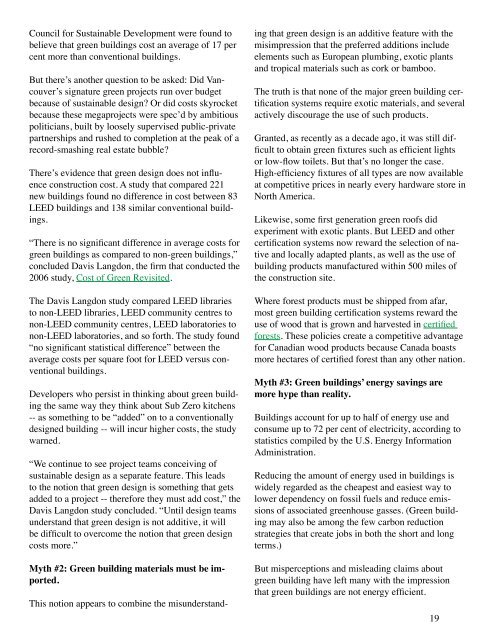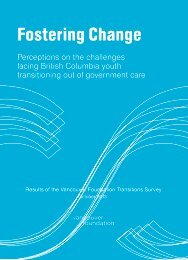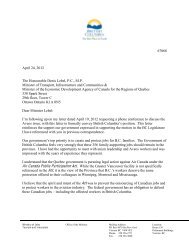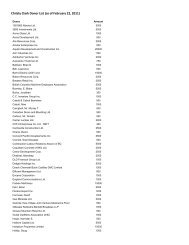from the ground up - The Tyee
from the ground up - The Tyee
from the ground up - The Tyee
You also want an ePaper? Increase the reach of your titles
YUMPU automatically turns print PDFs into web optimized ePapers that Google loves.
Council for Sustainable Development were found tobelieve that green buildings cost an average of 17 percent more than conventional buildings.But <strong>the</strong>re’s ano<strong>the</strong>r question to be asked: Did Vancouver’ssignature green projects run over budgetbecause of sustainable design? Or did costs skyrocketbecause <strong>the</strong>se megaprojects were spec’d by ambitiouspoliticians, built by loosely s<strong>up</strong>ervised public-privatepartnerships and rushed to completion at <strong>the</strong> peak of arecord-smashing real estate bubble?<strong>The</strong>re’s evidence that green design does not influenceconstruction cost. A study that compared 221new buildings found no difference in cost between 83LEED buildings and 138 similar conventional buildings.“<strong>The</strong>re is no significant difference in average costs forgreen buildings as compared to non-green buildings,”concluded Davis Langdon, <strong>the</strong> firm that conducted <strong>the</strong>2006 study, Cost of Green Revisited.<strong>The</strong> Davis Langdon study compared LEED librariesto non-LEED libraries, LEED community centres tonon-LEED community centres, LEED laboratories tonon-LEED laboratories, and so forth. <strong>The</strong> study found“no significant statistical difference” between <strong>the</strong>average costs per square foot for LEED versus conventionalbuildings.Developers who persist in thinking about green building<strong>the</strong> same way <strong>the</strong>y think about Sub Zero kitchens-- as something to be “added” on to a conventionallydesigned building -- will incur higher costs, <strong>the</strong> studywarned.“We continue to see project teams conceiving ofsustainable design as a separate feature. This leadsto <strong>the</strong> notion that green design is something that getsadded to a project -- <strong>the</strong>refore <strong>the</strong>y must add cost,” <strong>the</strong>Davis Langdon study concluded. “Until design teamsunderstand that green design is not additive, it willbe difficult to overcome <strong>the</strong> notion that green designcosts more.”Myth #2: Green building materials must be imported.This notion appears to combine <strong>the</strong> misunderstandingthat green design is an additive feature with <strong>the</strong>misimpression that <strong>the</strong> preferred additions includeelements such as European plumbing, exotic plantsand tropical materials such as cork or bamboo.<strong>The</strong> truth is that none of <strong>the</strong> major green building certificationsystems require exotic materials, and severalactively discourage <strong>the</strong> use of such products.Granted, as recently as a decade ago, it was still difficultto obtain green fixtures such as efficient lightsor low-flow toilets. But that’s no longer <strong>the</strong> case.High-efficiency fixtures of all types are now availableat competitive prices in nearly every hardware store inNorth America.Likewise, some first generation green roofs didexperiment with exotic plants. But LEED and o<strong>the</strong>rcertification systems now reward <strong>the</strong> selection of nativeand locally adapted plants, as well as <strong>the</strong> use ofbuilding products manufactured within 500 miles of<strong>the</strong> construction site.Where forest products must be shipped <strong>from</strong> afar,most green building certification systems reward <strong>the</strong>use of wood that is grown and harvested in certifiedforests. <strong>The</strong>se policies create a competitive advantagefor Canadian wood products because Canada boastsmore hectares of certified forest than any o<strong>the</strong>r nation.Myth #3: Green buildings’ energy savings aremore hype than reality.Buildings account for <strong>up</strong> to half of energy use andconsume <strong>up</strong> to 72 per cent of electricity, according tostatistics compiled by <strong>the</strong> U.S. Energy InformationAdministration.Reducing <strong>the</strong> amount of energy used in buildings iswidely regarded as <strong>the</strong> cheapest and easiest way tolower dependency on fossil fuels and reduce emissionsof associated greenhouse gasses. (Green buildingmay also be among <strong>the</strong> few carbon reductionstrategies that create jobs in both <strong>the</strong> short and longterms.)But misperceptions and misleading claims aboutgreen building have left many with <strong>the</strong> impressionthat green buildings are not energy efficient.19








